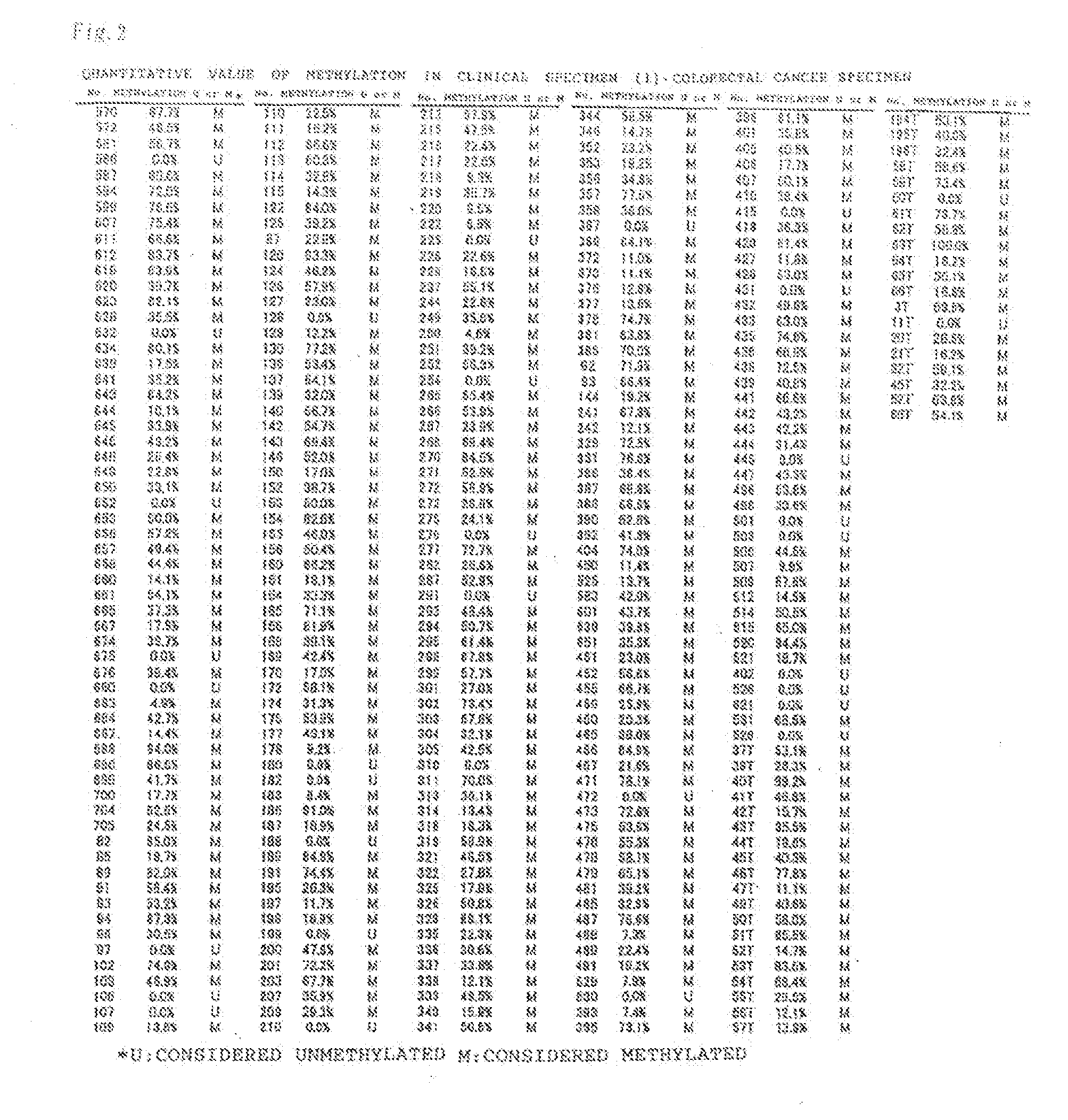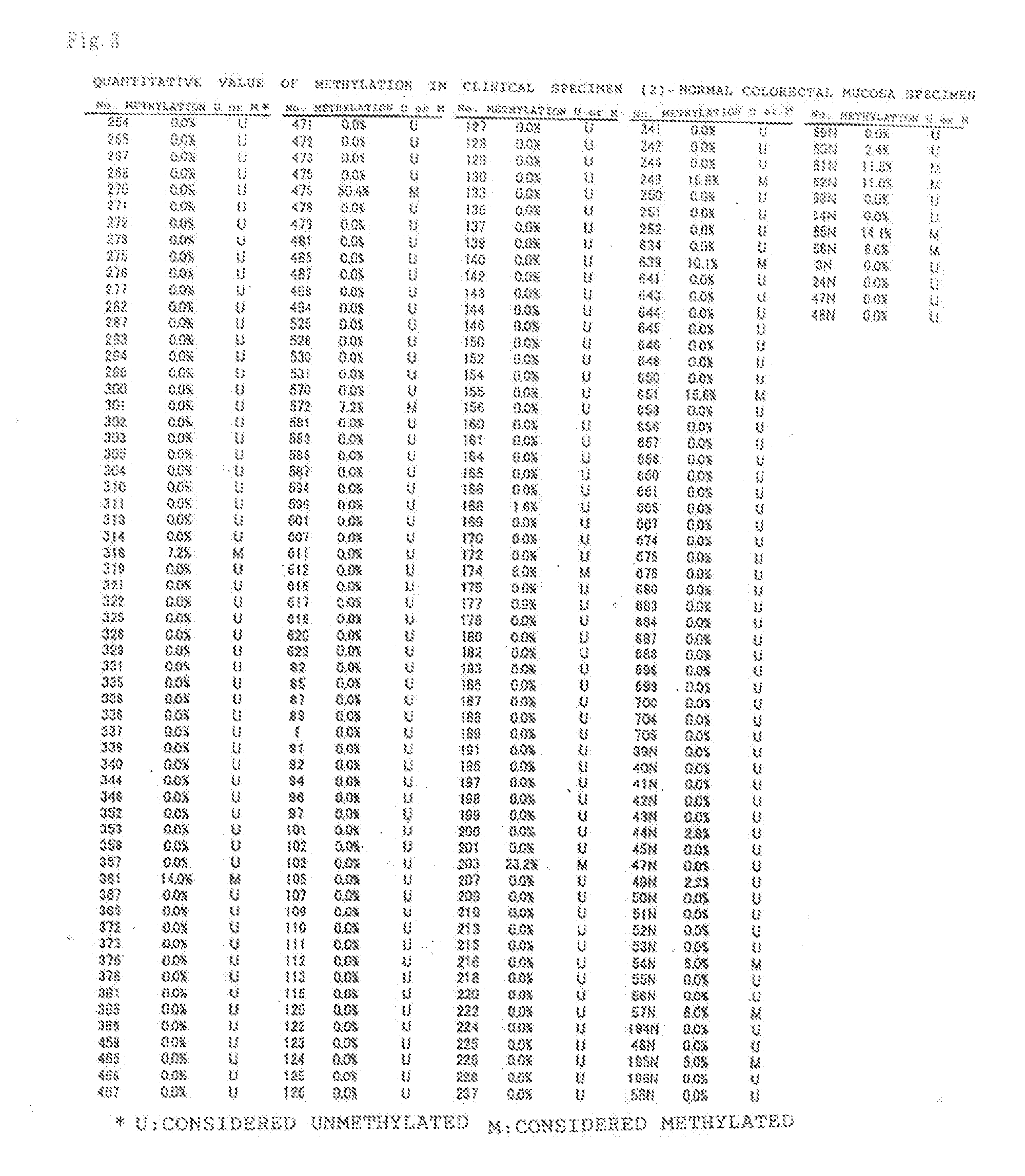Method for detection of colorectal tumor
a colorectal tumor and detection method technology, applied in the field of methods, to achieve the effect of simple detection of colorectal tumors, high specificity, and high sensitivity
- Summary
- Abstract
- Description
- Claims
- Application Information
AI Technical Summary
Benefits of technology
Problems solved by technology
Method used
Image
Examples
example 1
[0057](Extraction of DNA from Surgically Resected and Frozen Specimen)
[0058]The extraction of DNA from surgically resected and frozen specimens was carried out from 252 specimens of normal colorectal mucosa and 320 specimens of colorectal cancer using All Prep DNA / RNA Mini Kit (Qiagen, Hilden, GERM). 600 μl of RLT plus buffer included with the product was added to a 2-ml tube, to which 6 μl of mercaptoethanol was then added. Each surgically resected and frozen specimen was added thereto, to which one Stainless Steel Bead (5 mm) (from Qiagen) was then added to ultrasonically homogenize the specimen at 30 Hz for 10 minutes using Qiagen Mixer Mill MM300 (from Qiagen). The homogenized lysate was placed in an All Prep DNA spin column (from Qiagen) and centrifuged at 10,000 rpm for 30 seconds. A new All Prep DNA spin column was set in a 2-ml collection tube and incubated at room temperature or 4° C.
[0059]500 μl of AW1 buffer (included with the product) was added to the incubated DNA spin ...
example 2
[0075](Detection of Colorectal Adenoma Using Methylation of TWIST1 Gene as Measure)
[0076]Using the same protocol as that in Example 1, it was verified whether the methylation of TWIST1 gene could be a marker for colorectal adenoma as a benign tumor occurring in the colorectum.
[0077]189 paraffin-embedded specimens of formalin-fixed colorectal adenoma were subjected to the recovery of only a tumor site by microdissection, followed by DNA extraction using Qiagen DNA FFPE Tissue kit (from Qiagen). The extraction method was according to the protocol included with the product.
[0078](Preparation of Sample)
[0079]Control samples were prepared according to Example 1: a positive control for methylated allele was prepared from placenta-derived DNA (Sigma) treated with SssI methylation transferase (New England Biolabs) and a positive control for unmethylated allele, from DNA extracted from peripheral blood lymphocytes.
[0080](Treatment of DNA with Sodium Hydrogen Sulfite and Quantitative Analysis...
example 3
[0091](Use of Colorectal Cancer Cell Line)
[0092]Colorectal cancer cell lines were each used to examine the methylation of CpG sequences within the region between positions -477 and -747 of TWIST1 gene, specifically the methylation of CGCG at positions 57 to 60 and CpG at other places in the base sequence shown in SEQ ID NO: 1. DLD-1, HT-29, HCT-116, and RKO were used as colorectal cancer cell lines, and NL as peripheral blood lymphocyte-derived cells was employed as a methylation negative control and IVD as methylation transferase-treated DNA was employed as a methylation positive control. The methylation patterns of 10 clones (the methylation pattern of each of 10 cells) for the colorectal cancer cell lines (DLD-1, HT-29, HCT-116, and RKO) and the methylation patterns of 5 clones each of the methylation positive control (IVD) and the methylation negative control (NL) were examined. FIG. 24 is a chart showing the distribution of CpG methylation between positions -477 and -747 of TWI...
PUM
| Property | Measurement | Unit |
|---|---|---|
| Length | aaaaa | aaaaa |
| Chemical shift | aaaaa | aaaaa |
| Sensitivity | aaaaa | aaaaa |
Abstract
Description
Claims
Application Information
 Login to View More
Login to View More - R&D
- Intellectual Property
- Life Sciences
- Materials
- Tech Scout
- Unparalleled Data Quality
- Higher Quality Content
- 60% Fewer Hallucinations
Browse by: Latest US Patents, China's latest patents, Technical Efficacy Thesaurus, Application Domain, Technology Topic, Popular Technical Reports.
© 2025 PatSnap. All rights reserved.Legal|Privacy policy|Modern Slavery Act Transparency Statement|Sitemap|About US| Contact US: help@patsnap.com



